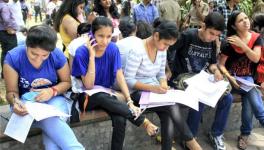Economy in Shambles, But PM Asking Culprits for Solution!

In case you have been wondering why Prime Minister Narendra Modi has been so silent of late, not uttering a word about the CAA/NRC (Citizenship Amendment Act and National Register of Citizens) protests and police killings or the continuing horror in Delhi’s Jawaharlal Nehru University or the stream of numbers showing how the economy is in shambles, here is the answer: Modi has been closeted continuously in meetings with a slew of corporate heads, economists, venture capitalists, and ministers and bureaucrats of all ministries.
The Richest Indian, Mukesh Ambani, Tata group's Ratan Tata, telecom czar Sunil Bharti Mittal, billionaire Gautam Adani, Mahindra Group chairman Anand Mahindra and mining baron Anil Agarwal were reportedly among those who attended the meeting.
According to glowing accounts in the media, Modi has personally taken charge of the economy, working from morning till night. It is reported that he has met 120 people so far – all of them top guns in their respective fields. They are CEOs of India’s biggest companies and wealth advisers and wealth fund managers. The very crème de la crème of India. Modi had once described them as the “wealth creators” of India, and so naturally he is consulting them on how to push India towards the lofty and grand target of making India a $5 trillion economy by 2024.
It appears that each ministry is making a detailed plan that is being personally reviewed by Modi on what they are going to do in the coming days. There is breathless anticipation among corporate media that the coming Budget, to be delivered on February 1, will have – you guessed it! – ‘Big Bang’ Reforms.
A sidelight of this fairy tale is that Finance Minister Nirmala Sitharaman has been totally sidelined in this exercise. It was reported, rather lamely, that she was attending meetings of the ruling Bharatiya Janata Party’s (BJP) frontal organisations, in order to collect views from the grassroots on how to boost the economy.
Harsh Reality
Now, take a quick look at the Indian economy. In last year’s Budget, the government had predicted a GDP (gross domestic product) growth rate of 7% for the current year. Latest government releases show that the expected growth rate is going to be about 5%, at constant prices. That’s an 11-year low.
In nominal terms (without adjusting for inflation), the last Budget predicted a GDP growth rate of 12% but this has dropped to 7.5%, as per latest official estimates. That’s the lowest since 1978, as many as 42 years ago.
The manufacturing sector is estimated to grow by just 2% this year, lowest in 13 years, since 2005-06. The construction sector is expected to expand at 3.2%, which is lowest in six years. Both these sectors employ a large number of people and slowing growth means fewer job opportunities.
The real killer lies in the estimated growth rate for agriculture, the mainstay for over 50% of the population. Its growth is estimated at a measly 2.8% this year, a notch less than the equally dismal last year’s figure of 2.9%. This, despite a very good harvest in kharif cropping season and an equally good one (hopefully) in the ongoing rabi cropping season.
As a result of this deadly slowdown, per capita income is projected to grow at 6.8% in 2019-20, which is the lowest since 2011-12. This is reflected in the fact that private consumption expenditure is predicted to grow by just 5.7 this year compared with 8.1% last year when the GDP was growing at 6.8%. Remember: private consumption expenditure makes up nearly 60% of GDP.
The now suppressed National Statistics Office report on consumer expenditure too had – in the leaked version – pegged a striking slowdown in consumption expenditure. It had said that average consumption expenditure in rural areas declined from Rs.1,667 per person per month (ppm) in 2014-15 to Rs.1,524 ppm in 2017-18. In urban areas, it dipped from Rs.3,212 ppm in 2014 to Rs.2,909 ppm in 2017-18. That’s a decline of 4.4% per year in rural areas and 4.8% in urban areas. There has never been such a sharp decline in family consumption spending ever since the government’s National Sample Survey Organisation’s consumption expenditure figures have been available.
All this has worsened the employment situation considerably. Over 7.3 crore people, mostly youth, are currently unemployed - perhaps the largest army of jobless people India has ever seen, according to Centre for Monitoring Indian Economy’s estimates. The aggregate unemployment rate was 7.7% in December 2019, the ninth month in which it has been above 7%. In urban areas, it was even higher at a staggering 8.9%, upending the widely held belief that urban centres are engines of job growth.
It's a Demand Slowdown
What does all this mean? Why is the economy slowing down? There are two ways in which answers are given. One, that there is flagging demand. The other, an opposite answer, is that there is a supply problem. Depending on the answer, corrective measures need to be taken.
The Modi government – and the bevy of people he is consulting – hold the view that if you kick up investment activity, everything will become alright. Businesses will invest more, creating more jobs, which will pump more money into the economy and economy will pick up as people will start spending more. This is a grievous, unpardonable error.
Have a look at this: investment is estimated to grow at less than 1% in the current year -- the lowest since 2004-05, that is, in 15 years. For last year, 2018-19 investment growth was 10%. Even during the 2008-09 economic slowdown, investment grew at faster pace.
It is the same Ambanis and Adanis and Tatas that lead investments. They have refused to put money into new productive capacities because they fear that it will sink in the face of inadequate demand. Despite the slew of concessions doled out by the Modi government, like slashing of corporate tax rates and giving free funds to real estate and other sectors, and not turning the screws on defaulting industrial houses, new investments have just not materialised. So, to expect these bigwigs to start investing now, is a pie in the sky. Yet, Modi is brainstorming with precisely these people.
Another way of leading more investment would be for the government to spend more. This would create more jobs, and increase people’s buying power, spurring demand and thus boosting the economy. But again, the Modi government and its international advisers are dead against it.
The government’s own finances are in shambles as revenue has barely grown compared with last year, according to latest report from the Controller General of Accounts (CGA) for November 2019. As a result, it is being estimated that government expenditure will suffer a drastic cut, perhaps as much as 7% or Rs.2 lakh crore compared with the Budgetary allocation for the current year. This is another grievous and unpardonable error.
Or, the government could declare increased wages for industrial and agricultural workers, expand and universalise the public distribution system, give increased prices to farmers, as demanded by working people who went on strike on January 8 for these and other demands. Yet, the government has so far obstinately refused to consider this and doesn’t even consult the workers and farmers for its planning. This is the third grievous and unpardonable error.
So, all the huffing and puffing by Modi and his cronies and servitors will lead to nothing – except that corporate houses will end up with more freebies.
Get the latest reports & analysis with people's perspective on Protests, movements & deep analytical videos, discussions of the current affairs in your Telegram app. Subscribe to NewsClick's Telegram channel & get Real-Time updates on stories, as they get published on our website.
























